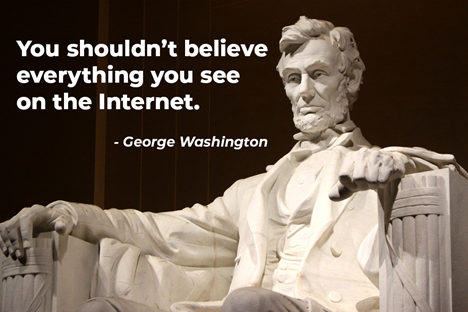Deepfakes: What you should know
Introduction

Photo Credit: Gage Skidmore
Abraham Lincoln—or was it George Washington?—said, “You shouldn’t believe everything you see on the Internet.” Among many areas of concern on the Internet is the developing area of deepfake photos, videos, and audio; in this article we explore identifying what they are, how they are used, and the potential danger they can pose to a ministry.
We in ministry have always dealt with dishonesty, lies, and deception, but the introduction of Deepfake technology adds
new complexities to the battle.
Definitions
An early example of a deepfake video appears in the movie Forrest Gump (1994). In that movie, Forrest purportedly meets three different presidents in scenes synthetically created by using special effects to combine historical footage with new video of Forrest. (Note: we always recommend discretion when viewing movies or watching any video online. Forrest Gump has a US rating of PG-13).
When the movie studio created Forrest Gump, the technology necessary to create deepfake videos was in its infancy. Today, 30 years later, anyone with a mind to be devious, and enough computer power, can download the tools necessary to create a deepfake video or audio. Today, most mobile phones have enough computing power.
Technology Involved
through fraud.” [3]
Consider the ease with which a person can change his/her background on a video conference platform such as Skype, MS Teams, or Zoom. Most of us have likely played with changing the wall of our home office to appear as though we are somewhere else—a different office, a different city, even a different planet. The ability to present a different background on these video platforms demonstrates the ease with which a deepfake video can be produced.
The technology to create a deepfake, either from scratch or by manipulation of an existing video or audio file, is becoming more available and requires less computing power all the time. There are many mobile phone apps and websites that allow you to create a deepfake video or audio. They are all classified as “Entertainment” apps.
Dangers
[4]
DeepFakeNow.com suggests five ways deepfakes may be used to manipulate, deceive, or inflict real harm:
- Political gain or political manipulation
- Financial fraud through phishing or “vishing,” a term to identify “voice phishing”
- Deepnudes and revenge pornography
- Deepfake identity fraud
- Fake news and hoaxes [5]
Business Insider suggests another popular use for deepfakes: “Deepfakes are not limited to just videos. Deepfake audio is a fast-growing field that has an enormous number of applications. Realistic audio deepfakes can now be made using [sophisticated] algorithms with just a few hours (or in some cases, minutes) of audio of the person whose voice is being cloned, and once a model of a voice is made, that person can be made to say anything, such as when fake audio of a CEO was used to commit fraud last year.” They stole almost $250,000. [6] [7]
EuroNews suggests that deepfake video technology could also be used by state actors to alter satellite imagery [8].
Fake social media accounts, complete with AI-generated photos and videos, are used to propagate and promote various political agendas and to report events that never happened. The purpose is to generate likes and reposts so the comments “go viral” and to sway opinions. The term for this is “sock puppets.”
In the world of missions and ministry organizations, we may think that we are immune from deepfake videos or photos or audio files. While that is likely true on the large scale, we may find ourselves a more likely victim at the local scale, especially by an individual or group who wants to discredit the Kingdom work we are doing. Deepfake videos of well-known Christian leaders may be more likely to “go viral” to a large audience. Here are two hypothetical
situations to consider: A bitter high-school student could create a deepfake video of a missionary or ministry leader saying things they never said or teaching something contrary to their mission. Or a group who wants to prevent a local church plant from being successful could create a deepfake video of the leaders engaging in illegal or immoral activities.
Another danger, especially for those who focus on Truth, is the undermining of belief in what is really true. This causes more and more people to question everything. “The mere idea of [deepfake] media is already making people stop believing that real things are real.” [9]
Just for Fun?
As indicated previously, the mobile phone apps that create fake videos and audio are all classified as entertainment. Most of what is created by these apps are used for fun, such as swapping your face with the actor in a famous movie scene.
Detection
They list issues with syncing, lighting, audio, and coloration inconsistencies as evidence to look for when attempting to identify deepfake videos. “Researchers are developing technology that can help identify deepfakes. For example, researchers at the University of Southern California and University of California, Berkeley are using machine learning that looks at soft biometrics such as how a person speaks along with facial quirks. Detection has been successful 92 to 96 percent of the time.” They offer 15 ways to spot deepfake videos [12].
Be aware; you shouldn't believe everything you see, especially if it is on the internet.
Reducing Risk: Prevention
Implementing these suggestions should make it less likely that you will be a victim or an “easy-target.”
LIMIT your posts. This includes both frequency (the number of posts) and distribution (to a specific, intended audience). Don't make your photos and/or videos available to the general public but, rather, only provide them to the audience you intend—an audience that will really benefit from the media. Most social media platforms have mechanisms which promise to give you control over who can see your posts. The more public you make your photos or videos on these platforms, the higher the risk of a nefarious actor grabbing them and modifying them to distribute as deepfakes.
CREATE a single online location for your videos, such as a personal YouTube channel or Vimeo channel. These online video hosting locations allow greater user control and maintenance of personal video content as they focus on video, and currently, allow for greater user control of posted content. This means we recommend against posting the same video to multiple sites, including FaceBook, Instagram, and Twitter, as they typically are more difficult to control
content. You can post a link on these sites to your video library on YouTube or Vimeo, for example.
What prevention does this strategy allow? Having your videos contained on a personal video channel offers you the ability to challenge the presence of a faked video. By setting a pattern of usage on YouTube or Vimeo, a deepfake video of you appearing in another place doesn't have the ring of authenticity.
ASK your audience to avoid forwarding, or linking, or re-posting, photos or videos of you. Instead, request that the audience ask you to re-post, or forward, any photo or video to a different audience as deemed necessary. Alternatively, a member of your audience may recommend that an outsider be added to your audience group on the social media platform of your choice.
STAY consistent in your message and posting. The more consistent you are with your messaging, the easier it will be to debunk any fake videos using your image or voice. We wish it wasn't necessary to say this, but avoid or limit political debate, or “hot topics” as they may put you squarely in the cross-hairs of a nefarious actor seeking to discredit you, your cause, and possibly even your organization.
REMOVE any videos that are no longer valid or current. This strategy goes along with the prior suggestion of using specific video-hosting locations. You should consider archiving and removing older videos, such as your newsletter video from 2017. By removing out-of-date videos from your video channel, you are reducing the number of items people can use to create a deepfake.
Reducing Risk: Mitigation
REPORT any fake videos of yourself to the platform they are on, such as FaceBook, YouTube, Instagram, etc. Request that the deepfake media be removed from their platform and their storage, and backups. Depending on the severity, ask them to report the incident to authorities, such as a cyber-crimes unit.
You as an individual may also want to report the deepfake to a cyber-crimes unit.
- YouTube – Deepfakes violate their Impersonation Policy. To begin the reporting process, on the video's page click the three dots (…) below and to the right of the video then click Report.
- Instagram – Deepfakes are seen as Fraud. To begin the reporting process, on the video's post click the three dots (…) in the top right corner.
- FaceBook – Deepfakes violate their False Information policy. To begin the reporting process, on the video's post click the three dots (…) in the top right corner.
- Vimeo – Deepfakes are seen as harassment therefore they fall under their “Not playing nice” category. To begin the reporting process, while playing the video click the flag icon located on the very far right and lower corner of the black video viewing area.
KEEP the original of any video you post online, so you have a piece of evidence of what you originally posted. This can be presented as evidence to both social media platforms, and any investigative entities seeking to find the nefarious actors of the deepfake.
Don't be Deceived
- Research the content to see if anyone has reported it as being fake. Do an online search with keywords such as the person or subject involved, the topic, and the word “deepfake.”
For example, “Abraham Lincoln Internet believe deepfake” - Watch the video or listen to the audio very carefully to see if you can detect anything that doesn't seem right. (You may not).
- Evaluate if the content aligns with what you already know about the speaker(s) and what they would say.
- Ask yourself if you agree with what you see or hear simply because it confirms what you already believe.
- Never forward or share any content unless you are certain of its validity.
Additional Resources
- What are deepfakes? How they work and how to spot them
- What are deepfakes? How fake AI-powered audio and video warps our perception of reality
- 'Deepfake geography' could be the latest form of online disinformation
- Deepfakes Create Many Moral Messes
- A New Hermeneutics of Suspicion? The Challenge of deepfakes to Theological Epistemology
References
- "Deepfake", Wikipedia, 16 April 2021. en.wikipedia.org/wiki/Deepfake
- Arnold, “5 Ways in Which Deepfakes are used by People to Manipulate.” Deepfakenow. 21 April 2020. deepfakenow.com/what-are-deepfakes-used-for/
- Arnold, “5 Ways in Which Deepfakes are used by People to Manipulate.” Deepfakenow. 21 April 2020. deepfakenow.com/what-are-deepfakes-used-for/
- Benscoter, Jane, “Pa. woman created ‘deepfake' videos to force rivals off daughter's cheerleading squad: police,” PennLive, 17 March 2021, www.pennlive.com/news/2021/03/pa-woman-created-deepfake-videos-to-force-rivals-off-daughters-cheerleading-squad-police.html
- Arnold, “5 Ways in Which Deepfakes are used by People to Manipulate.” Deepfakenow. 21 April 2020. deepfakenow.com/what-are-deepfakes-used-for/
- Johnson, Dave, “What is a Deepfake? Everything you Need to Know.” BusinessInsider, 22 Jan 2021, www.businessinsider.com/what-is-deepfake
- “Unusual CEO Fraud via Deepfake Audio Steals US$243,000 From UK Company.” TrendMicro, 5 Sept 2019, trendmicro.com/vinfo/us/security/news/cyber-attacks/unusual-ceo-fraud-via-deepfake-audio-steals-us-243-000-from-u-k-company
- Campbell, Hebe and Holroyd, Matthew, “‘Deepfake geography' could be the latest form of online disinformation”Matthew, euronews, 5 July 2021, euronews.com/2021/05/07/deepfake-geography-could-be-the-latest-form-of-online-disinformation
- Hao, Karen, “The biggest threat of deepfakes isn't the deepfakes themselves,” Technology Review, 10 Oct 2019. www.technologyreview.com/2019/10/10/132667/the-biggest-threat-of-deepfakes-isnt-the-deepfakes-themselves/
- “Deepfake Queen to deliver Channel 4's Alternative Christmas Message,” Channel4, 24 December 2020, www.channel4.com/press/news/deepfake-queen-deliver-channel-4s-alternative-christmas-message
- Johansen, Alison Grace, “Deepfakes: What they are and why they're threatening,” Norton, 24 July 2020, us.norton.com/internetsecurity-emerging-threats-what-are-deepfakes.html
- Johansen, Alison Grace, “How to spot deepfake videos — 15 signs to watch for,” Norton, 13 Aug 2020, us.norton.com/internetsecurity-emerging-threats-how-to-spot-deepfakes.html
